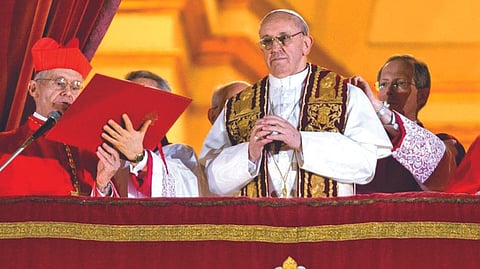

You know that it was the duty of the conclave to give Rome a bishop. It seems that my brother cardinals have gone to the ends of the Earth to get one...”: that was how Pope Francis first greeted the crowd outside St. Peter’s Basilica on March 13, 2013. Few of the thousands of worshippers gathered in the square knew much, if anything, about the Argentine Jesuit, Cardinal Jorge Mario Bergoglio. Before the conclave, the archbishop of Buenos Aires had not attracted much media attention outside of his homeland.
He was well known in Catholic circles, however, having already been given serious consideration to succeed the late Pope John Paul II in 2005. But the job went to Cardinal Joseph Ratzinger of Germany, who became Pope Benedict XVI. Ten years later, no one asking “Jorge who?” But many people all over the world still wonder what exactly this pope stands for. He is at once approachable and familiar, yet in some ways stubbornly opaque.
But there is one thing that all Catholic experts can agree on: Pope Francis is different. Bergoglio, already unique for being the first non-European pope since the eighth century, caused another sensation when he chose his papal name. While many pontiffs have spoken with admiration about Saint Francis of Assisi, who preached extensively about the need for Christians, especially clergymen, to emulate Jesus by living in poverty, and about respect for the natural world, no pope had ever honored him by taking his name before.
The choice of name was immediately taken as a sign of the new pope’s approach to church policy. “Pope Francis is a Franciscan Jesuit,” Dutch Vatican reporter Hendro Munsterman told DW. “He values poverty, simplicity, the environment and interfaith dialogue. He wants to fix the church like the 13th-century saint did because it’s broken.” Munsterman, himself a theologian, has been covering Francis since the beginning of his pontificate.
The pope’s emphasis on simplicity has been apparent in many small ways since March 2013: Francis, wearing worn-out shoes, took up quarters not in the Apostolic Palace, but in the Vatican guest house. He prefers to meet with people at the margins of society, like refugees and prisoners. When he travels, he prefers a small Fiat or Renault to luxury cars.
These small signs have been matched by big words. In 2015, Francis made headlines around the world when his environmental encyclical Laudato Si called for swift and unified global action against climate change, consumerism and irresponsible development. He also attended the 2015 UN Climate Change Conference to support this message.
Quite a few of his 40 trips abroad as pope have taken him to the margins of society in whatever country he is visiting, and he has sharply criticised industrialised nations for taking advantage of poorer countries. During the COVID-19 pandemic, he urged wealthier nations to commit to sharing vaccines with developing countries.
Despite the Catholic Church’s attempts to be above politics, it is nevertheless a geopolitical force. And Francis’ tenure has shaken up centuries of Church eurocentrism.
“It is clear that Pope Francis is the first truly global pope… who has liberated Catholicism from the ideas of a moralistic middle-class bourgeois,” that long defined it, church historian Massimo Faggioli told DW.
Visit news.dtnext.in to explore our interactive epaper!
Download the DT Next app for more exciting features!
Click here for iOS
Click here for Android